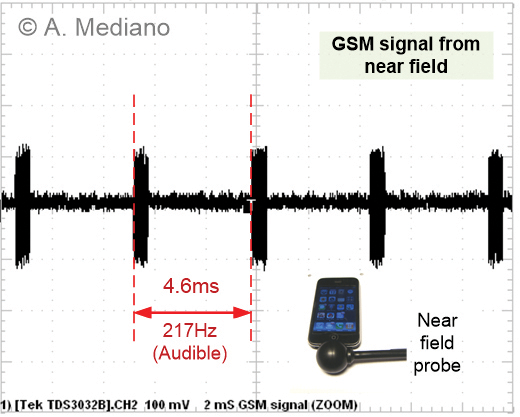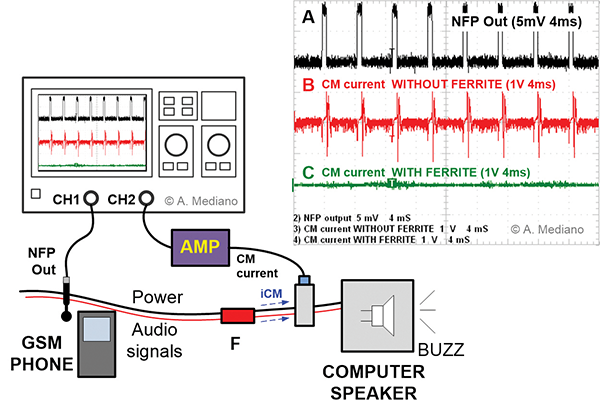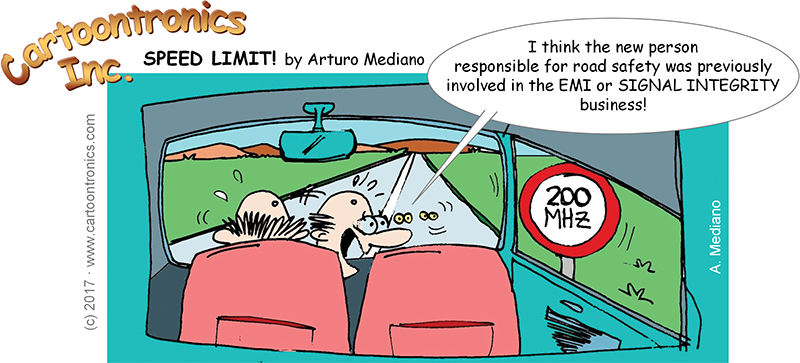RF signals entering in a system and being rectified can interfere seriously. That has been classically the case of audio noise in speakers because of mobile phones using TDMA technology. The problem is now very common in products with wireless RF funcionality in products with audio areas.
Audio rectification is a common EMI problem I have found several times in my troubleshooting experience. This problem is related to a high frequency signal affecting a low frequency system (supply, bias points, speakers, microphones, and audio circuits, etc.)
The high frequency signal is radiated from a nearby intended transmitter such as single-sideband phones, amateur radio, AM broadcast stations, walkie talkies, etc., or unintended sources as turn ON-OFF in motors, lighting, ESD, etc.
The effect can be detected usually as a distorsion in the victim signal, on-and-off humming or clicking. Do you remember the noise from the speakers of your computer when your phone is in the vicinity?: “tac-tac-tac”
Some years ago I was involved in a problem where gain of a broadcast transmitter was modified because EMI affected the bias point of the power amplifier MOSFET transistors. How is possible that a high frequency signal can interfere with such a low frequency victim?
The problem is known as audio rectification because the high frequency signal is rectified with any nonlinear device or effect in the victim circuit (usually PN junctions).
See Figure 1 for a graphical description. If the RF signal is a continous wave (CW), the result is a DC level shifting (for example a bias point can be altered). If the RF signal is amplitude modulated, the result is EMI following the envelope of the interfering signal.

Usually in audio rectification problems the victim cables pick up RF signals because they act as receiving antennas.
A typical example of this effect is the noise from mobile phones using Time Division Multiple Access (TDMA) technology as GSM to nearby audio systems using speakers.
Let me show you the effect with a simple experiment using one of my near field probes close to a GSM phone (Figure 2). From the basics of TDMA theory, the GSM signal, has a multiframe structure with 26 frames (4.6 ms each) in 8 timeslots lasting for 120ms. Note that horizontal scale is 2ms so a 4.6ms pulsed waveform (217Hz) is obtained which lies in the audible range.

If that RF pulsed envelope enters the audio path, will be rectified producing audible noise (buzz) in speakers. I have reproduced the speakers problem in the lab (Figure 3).

A GSM phone is located near the cables (power and audio) of a computer speaker and a near field probe is used to pick-up the RF signal from the phone for triggering purposes connected to scope channel CH1.
The inducted common mode currents in cable were measured with a current probe and a small linear amplifier for increased dynamic range. Ferrite F was used to solve the problem in the second part of the experiment.
Waveform A (black) in Figure 3 is the triggering signal (RF sample) from channel CH1. Waveform B (red) is common mode current in cables when the noise in speakers is annoying.
A ferrite core F was included to solve the problem: the audio noise was clearly reduced and the common mode currents to the speakers were minimized as shown in waveform C (green).
You can minimize audio rectification problems avoiding long leads and cables, avoiding big loops, using non-susceptible technology, and shielding or filtering (with capacitors or ferrites).
The final advice: the best approach is to consider the problem at the beginning of the project and to test for immunity as soon as possible. Test your prototypes injecting EMI as an RF signal modulated in AM (i.e. 1kHz 80%) and you will be able to locate sensitive areas in your design.
 Arturo Mediano received his M.Sc. (1990) and his Ph. D. (1997) in Electrical Engineering from University of Zaragoza (Spain), where he has held a teaching professorship in EMI/EMC/RF/SI from 1992. From 1990, he has been involved in R&D projects in EMI/EMC/SI/RF fields for communications, industry and scientific/medical applications with a solid experience in training, consultancy and troubleshooting for companies in Spain, USA, Switzerland, France, UK, Italy, Belgium, Germany, Canada, The Netherlands, Portugal, and Singapore. He is the founder of The HF-Magic Lab®, a specialized laboratory for design, diagnostic, troubleshooting, and training in the EMI/EMC/SI and RF fields at I3A (University of Zaragoza), and from 2011, he is instructor for Besser Associates (CA, USA) offering public and on site courses in EMI/EMC/SI/RF subjects through the USA, especially in Silicon Valley/San Francisco Bay Area. He is Senior Member of the IEEE, active member from 1999 (Chair 2013-2016) of the MTT-17 (HF/VHF/UHF) Technical Committee of the Microwave Theory and Techniques Society and member of the Electromagnetic Compatibility Society. Arturo can be reached at a.mediano@ieee.org. Web: www.cartoontronics.com.
Arturo Mediano received his M.Sc. (1990) and his Ph. D. (1997) in Electrical Engineering from University of Zaragoza (Spain), where he has held a teaching professorship in EMI/EMC/RF/SI from 1992. From 1990, he has been involved in R&D projects in EMI/EMC/SI/RF fields for communications, industry and scientific/medical applications with a solid experience in training, consultancy and troubleshooting for companies in Spain, USA, Switzerland, France, UK, Italy, Belgium, Germany, Canada, The Netherlands, Portugal, and Singapore. He is the founder of The HF-Magic Lab®, a specialized laboratory for design, diagnostic, troubleshooting, and training in the EMI/EMC/SI and RF fields at I3A (University of Zaragoza), and from 2011, he is instructor for Besser Associates (CA, USA) offering public and on site courses in EMI/EMC/SI/RF subjects through the USA, especially in Silicon Valley/San Francisco Bay Area. He is Senior Member of the IEEE, active member from 1999 (Chair 2013-2016) of the MTT-17 (HF/VHF/UHF) Technical Committee of the Microwave Theory and Techniques Society and member of the Electromagnetic Compatibility Society. Arturo can be reached at a.mediano@ieee.org. Web: www.cartoontronics.com.

